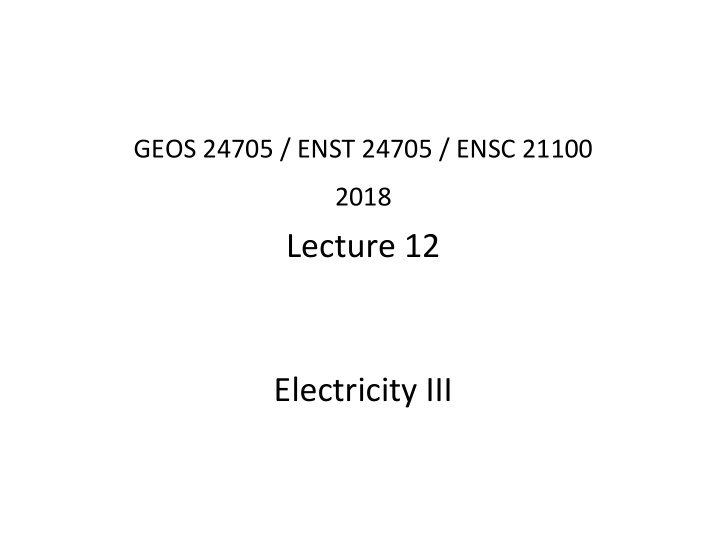



GEOS 24705 / ENST 24705 / ENSC 21100 2018 Lecture 12 Electricity III
Split-ring commutator allows brushed DC motor Magnetic field lines video
Force on a brushed DC motor
“Slip-ring” commutator produces / works with AC
Direct current (DC) Proponent: Edison Advantages: • Understandable • Available motors • Charges ba5eries • Available meters Disadvantages • Cannot transform Also invented: voltage easily • Lightbulb (commercial) CommercializaJon • Phonograph • London 1882 • Improved • New York 1882 telegraph Early DC generator, “long- (both coal) legged Mary Anne”, 1884
Alternating current (AC) Proponent: Tesla (former Edison AC dynamo, Chicago 1893 engineer) Advantages: • Transforms voltage easily Disadvantages • No reliable motors available • No ba5ery charge Also invented: CommercializaJon • InducJon AC motor • Ames hydro: 1891 • Radio communicaJon • Chicago coal: 1893 • Wireless energy transmission • Niagara hydro: 1895
Edison vs. Tesla: “war of the currents” DC Edison’s company: General Electric, founded 1890, now ranked (Forbes, 2009) the largest company in the world. Precursor: Edison Illuminating Co., 1880 Technical achievement: First steam-powered electricity & electric utility, 1882, first U.S. transmission standard, multiple power plants (~1 mi. transmission) (for lighting only) PR stunt: invented (AC) electric chair, attempted execution, 1890 AC Tesla’s company: Westinghouse Electric Company, founded 1886, now (after purchase of CBS) knows as CBS Corp. (sold power generation to Siemens, itself provider of first electric street lighting in 1881). Hired first woman electrical engineer in 1890s. Technical achievement: long-distance transmission of hydropower at Niagara Falls to factories in Buffalo New York, 1895 (25Hz) PR stunt : lit Chicago World’s Fair, 1893
Edison vs. Tesla at 1893 Chicago World’s Fair Tesla’s system already had most characteristics of the modern electricity system in 1893.. World’s Fair + choice at Niagara 2 years later committed us to AC Comparatively little evolution after choice was made – standardization of frequencies.
By 1893 generators much larger than Edison’s first 1000 hp AC generators exhibited in Chicago World’s Fair
1893 Chicago World’s Fair lighting awed the U.S. Image: Chicago History Museum/ Getty Images
1890: engineering decisions on Niagara Falls hydro: long-distance transmission, ~ 20 miles to Buffalo mo8vated by beau8fica8on, early environmental ac8vism – the “Free Niagara Movement” pushed to shiD industry away from falls
How to transmit the power? long-distance transmission, ~20 miles to Buffalo 1890 proposals received: Mechanical • Belts (steel cables on posts or pulleys) • Compressed air • High-pressure water Electrical • DC current (transmit at up to 16,000 volts) • AC current (transmit at 10,000 volts) Wes8nghouse didn’t submit: waited for invita8on to bid on project, bid submiLed 1893, same year as World’s Fair, won contract
Tesla’s system installed at Niagara Falls 1895-1897
Tesla’s AC system installed at Niagara Falls 1895-1897
First overhead power lines 11,000 volt lines (later upgraded to 22,000 V) carrying power from Niagara to Buffalo, ~ 20 miles away No8ce: no automobiles yet. The first automobile company had started only 2 years before; by 1895 only ~10 total cars had been sold in the U.S.
Use of heat engines preceded electricity by > 100 years STEAM ELECTRICITY 1690 Papin concept of steam engine 1712 Newcomen reciprocating engine 1765 Watt’s improved engine 1800 battery (Volta, Davy) 1820’s invention of steam locomotive 1820 electricity & magn. related (Oersted) 1825 Carnot calls steam engines the 1821 first motor (Faraday) source of England’s strength 1831 first generator (Faraday) 1866 dynamo (Siemens) 1870s dynamo used for arc furnaces 1884 steam turbine (Parsons) 1880s lightbulb, first distribution (Edison) 1883 AC motor (Tesla) 1893 Chicago World’s Fair electrified with Tesla’s AC power (25 Hz) 1895 transmission from Niagara Falls 1920 Lenin calls to electrify Russia
Most lines are mulPples of 3 Image: NationalGrid Image: PennLive.com
Tesla’s transmission was “three-phase” Note magnet is in rotor, not in stator
3-phase power transmission has advantages Power ( α V 2 ) sums to a constant – no fluctua8ons in power transmiLed Voltages (and current) sum to 0 if perfectly balanced – no need for a return wire, which saves costs
Recommend
More recommend